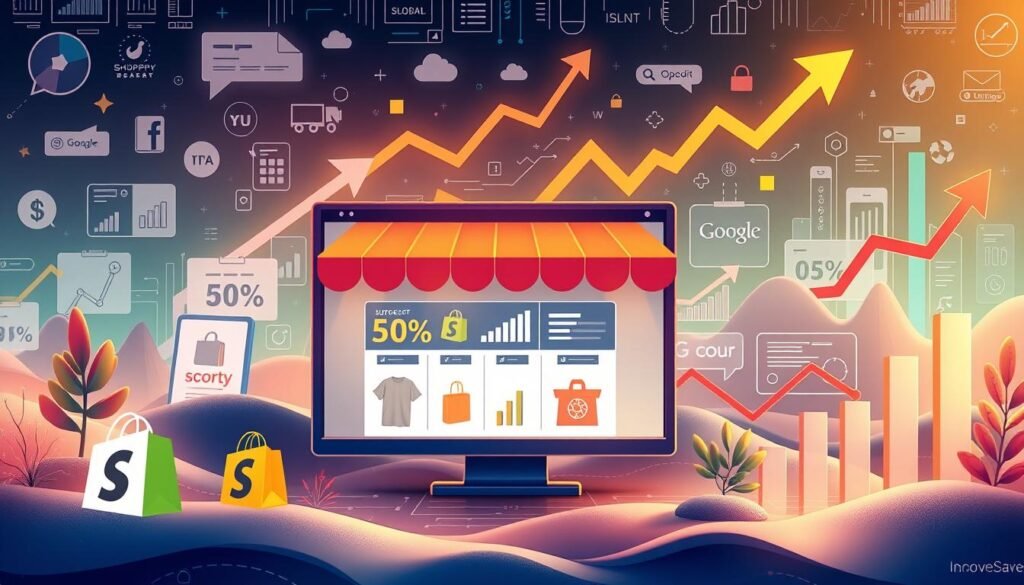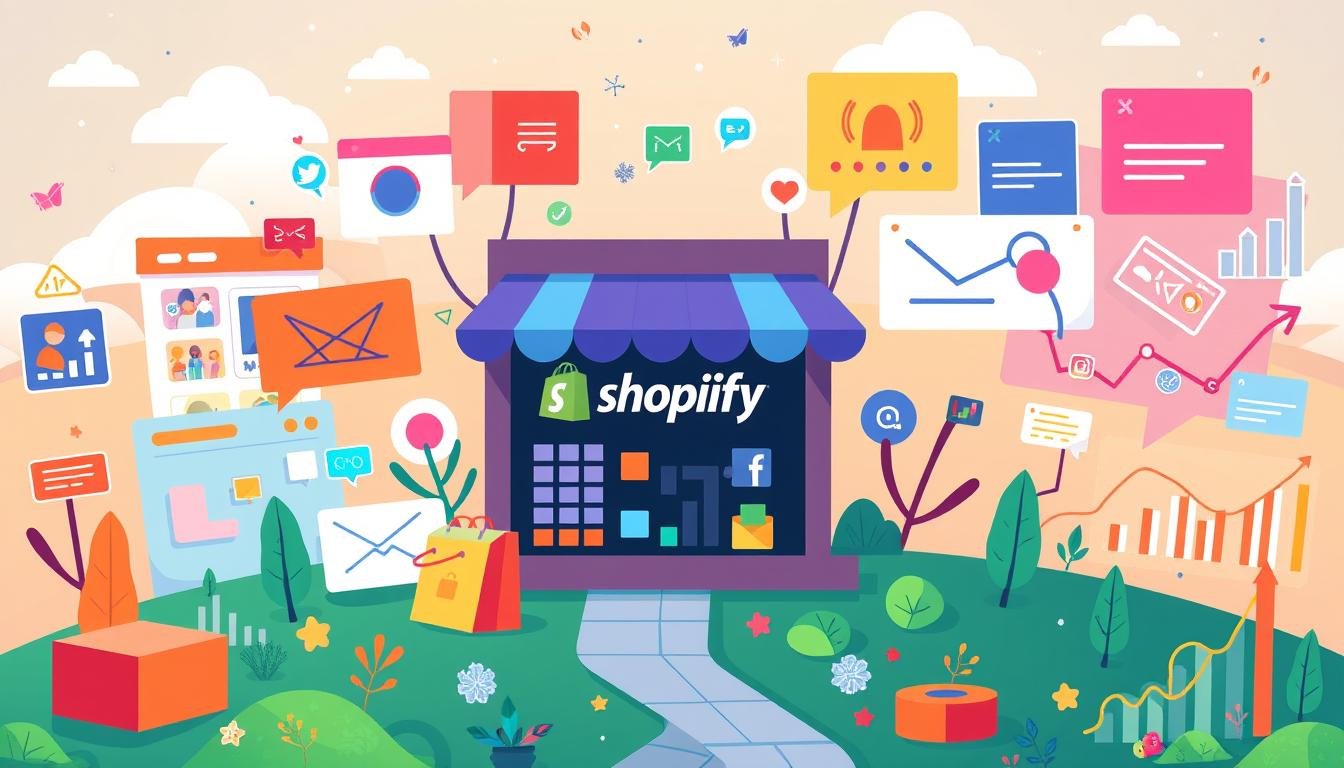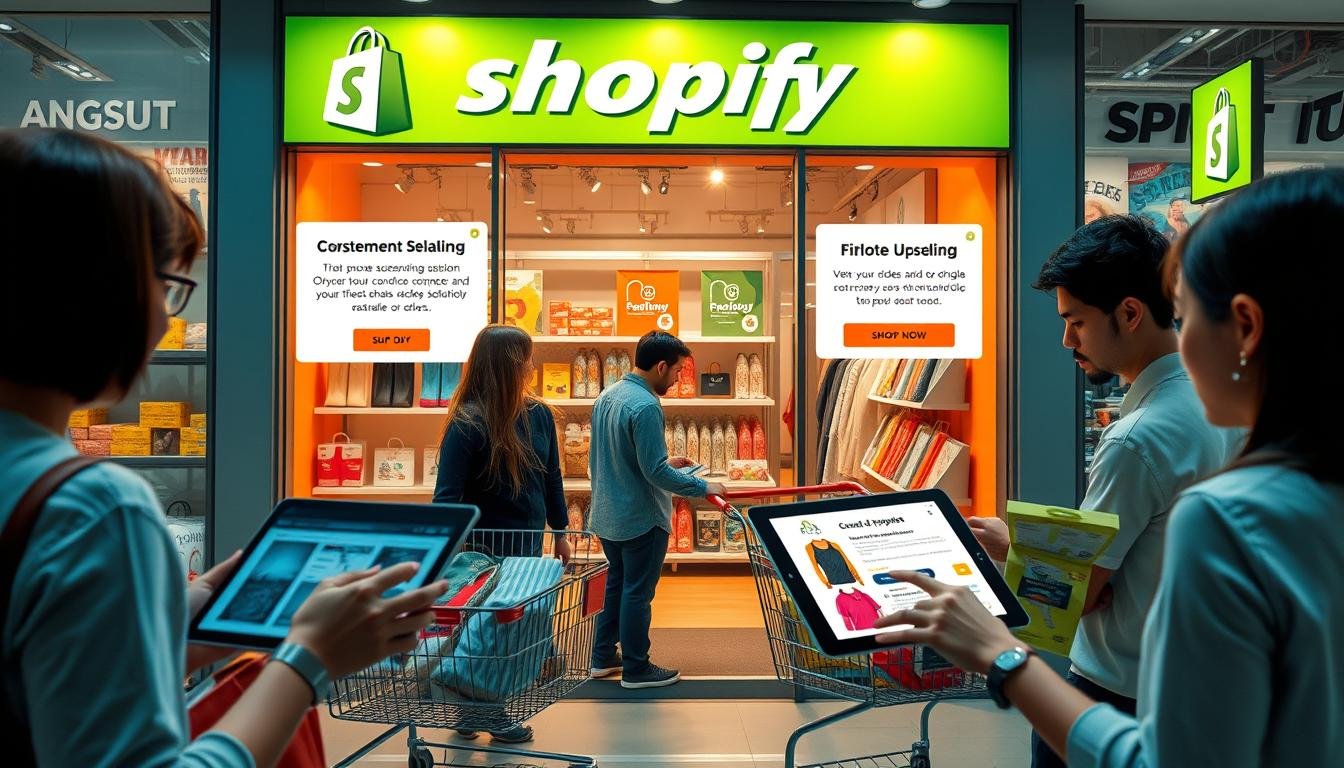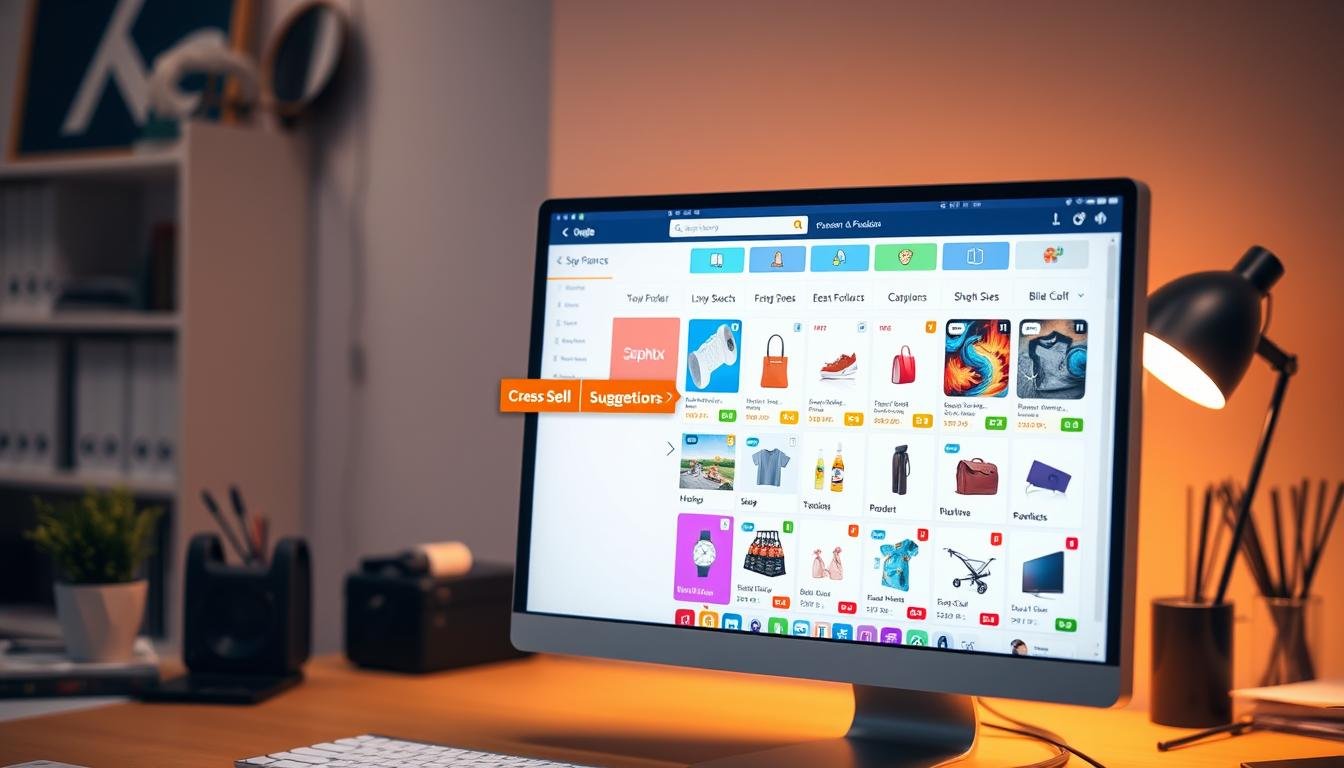Did you know Shopify supports over 4.7 million businesses worldwide? Yet, not all are making money. To stand out, you need to use smart marketing strategies for your Shopify store. This guide will show you how to promote your store and increase sales.
Key Takeaways
- Email marketing can bring up to $36 for every dollar spent, making it a smart choice.
- Small businesses aiming for Google’s top spots need time and effort for SEO.
- Loyalty programs can keep customers coming back, boosting repeat business.
- Apps like Privy and Justuno can make your site more effective at converting visitors.
- Social media, like Facebook, Instagram, and TikTok, is key for marketing.
- Using content from your customers can convince others to try your brand.
- Referral marketing can lead to big profits, as seen with Branch Basics.
Introduction to Promoting Your Shopify Store
Promotion is key for your Shopify store. It’s not just about opening up shop and hoping customers will find you. It’s about actively working to increase online visibility and drive traffic to your store. Without a solid promotion strategy, your store might get lost in the crowded eCommerce world.
Why Promotion Is Critical for Shopify Stores
The eCommerce world is very competitive, with millions of Shopify stores competing for attention. Over 60% of consumers have made a purchase based on a blog post. This shows that strategic promotion is vital. SEO is important for driving organic traffic, leading to higher visibility and sales.
Social media platforms like Facebook, Instagram, and TikTok offer engaging formats and huge user bases. Ignoring promotion could mean your store fails to generate meaningful revenue.
Promotion makes successful stores stand out, turning them into revenue-generating machines.
Setting Your Initial Goals and KPIs
Setting clear goals and KPIs at the start is essential. These benchmarks guide your marketing efforts, helping you see what works and what doesn’t. Strategies like SEO, email marketing, and social media campaigns can boost online visibility and drive targeted traffic.
For example, triggered emails can reach the right people at the right time with relevant content. Tracking these efforts helps keep focus and improve tactics over time.
Another important part is integrating your Shopify store with platforms like AdRoll for better customer acquisition. A consistent, well-measured promotion strategy will help your store succeed, driving traffic and increasing sales.
Optimizing Your Shopify Store for Search Engines
SEO strategies can make your Shopify store shine in the online world. It’s about finding the right keywords and making sure your site is perfect for search engines. Let’s explore how to make your store a hit online.
Keyword Research and Implementation
Keyword research is key to SEO success. It’s about finding the words your customers are searching for. Use tools like Google Analytics and Google Search Console to see what keywords your competitors use. Choose long-tail keywords that match your products to boost your store’s search ranking.
When using keywords, do it smartly. Put main keywords in:
- Title tags and meta descriptions
- Headings and subheadings
- Product descriptions and alt text for images
Make sure each element is useful and engaging for users.
On-Page SEO Strategies
With the right keywords, focus on on-page elements. First, make sure your site works well on mobile devices. A responsive design is good for both users and search engines. Most Shopify themes are mobile-friendly, so your store looks great on any device.
| On-Page SEO Element | Optimization Tips |
|---|---|
| Title Tags | Include main keywords and keep them under 60 characters. |
| Meta Descriptions | Write compelling descriptions that include primary keywords and are within 160 characters. |
| Images | Ensure images are in WebP format and have descriptive alt text. |
| Site Speed | Optimize images, use fast themes, and enable compression to improve load times. |
| Internal Links | Link to related content within your site to improve navigability and SEO. |
Keep checking and updating your SEO efforts. Search trends change, and so should your strategies. By following these tips, you can boost your store’s ranking and attract more visitors.
Engaging Your Audience on Social Media
Using social media well can really help your Shopify sales. It’s key to mix organic and paid strategies. This way, you reach more people and get better results.
Organic Social Media Strategies
Organic strategies help build a loyal community. They offer real engagement without paid ads. Here are some important tactics:
- Create High-Quality Content: Use photos and videos to catch attention and build trust, as David Mason suggests.
- Engage Actively: Talk to your followers through comments and likes. This builds a community and keeps customers coming back, Mark Ainsworth says.
- User-Generated Content (UGC): Get customers to share your products. This adds authenticity and proof of quality.
Paid Social Media Advertising Tips
Paid ads are key to boosting Shopify sales. They help you target specific groups and get noticed fast. Here are some tips:
- Utilize PPC Advertising: Use platforms like Facebook and Instagram for targeted ads. They work on a pay-per-click basis.
- Combine Organic and Paid Efforts: Mix ads with organic content, Micah Albert advises. This works well on Instagram and TikTok.
- Leverage Influencers: Work with influencers, big or small. Tailor your strategy to fit your goals and budget for better results.
| Organic Strategies | Benefits |
|---|---|
| Create High-Quality Content | Builds Trust and Authenticity |
| Active Engagement | Fosters Community and Customer Loyalty |
| User-Generated Content (UGC) | Enhances Social Proof and FOMO |
By using both organic and paid strategies, you can boost your Shopify store’s visibility. This drives sales and reaches more people. Keep trying new things to see what works best for your audience and goals.
Running Effective Email Marketing Campaigns
Email marketing is key to reaching out to customers and growing your Shopify store. It lets you talk directly to your audience. This can lead to more repeat business and new offers.

Building Your Email List
Having a strong email list is the first step in email marketing. Use double opt-in forms to make sure your list is good quality. This follows rules like GDPR. Tools like Klaviyo or Mailchimp help get real email addresses.
- Put sign-up forms on your website.
- Give discounts or free eBooks for signing up.
- Use double opt-in to stop fake sign-ups.
Welcome emails are very important. They have an open rate over 86%. They help connect with new subscribers right away.
Crafting Engaging Email Content
Personalizing emails is important. Use names and tailor content to what people like. This can make emails more interesting and increase interaction.
- Make subject lines and content personal.
- Send different emails, like reminders and offers, to keep people interested.
- Keep emails casual and friendly.
Using a real sender address can lead to more feedback. This builds trust and keeps people engaged.
Automating Your Email Marketing
Email automation is vital for keeping in touch with your audience. Tools like Shopify Email, Mailchimp, and Klaviyo help send emails automatically. This includes reminders, seasonal campaigns, and offers.
| Email Type | Purpose | Average Open Rate |
|---|---|---|
| Welcome Emails | Introduce new subscribers, thank them, and offer a discount code | 90.09% |
| Cart Abandonment Emails | Encourage customers to complete purchases, often with incentives | 40.28% |
| Promotional Emails | Promote sales, discounts, and new products | 22.78% |
A/B testing is also key. It helps you find the best subject lines, buttons, and content. This is based on how many people click on them.
By using these strategies, you can better engage customers and grow your Shopify store.
Partnering with Influencers
To boost your Shopify store’s visibility, working with influencers is a smart move. They have a loyal following that trusts their advice. This makes them perfect for promoting your products. Using Shopify store promotion tips through influencers can really increase online visibility.
Instagram is the top choice for influencer marketing, and it will stay that way until 2025. Almost 49% of all participants and 87% of Gen Z say they buy products based on influencer recommendations. TikTok is a close second, with user numbers expected to hit 955 billion by 2025. Nano influencers, with 1,000 to 10,000 followers, have an engagement rate over 4%, making them a cost-effective choice.
Companies that use influencer marketing see a return of $6.50 for every dollar spent. The type of influencer you choose affects both cost and engagement. Micro-influencers engage often and target specific audiences. Mid-tier influencers offer segmented audiences at a lower cost than bigger influencers. Macro-influencers can reach a lot of people but are more expensive.
Working with influencers can boost your brand’s awareness, credibility, and sales. Successful partnerships can open up new markets.
Millennials and Gen Z love buying products based on influencer recommendations. 56% of Millennials and 58% of Gen Z do this. This shows how important influencer collaborations are for Shopify store promotions.
Let’s look at the different influencer tiers you can consider for your Shopify store:
| Influencer Tier | Follower Range | Advantages | Costs |
|---|---|---|---|
| Nano Influencers | 1,000-10,000 | High engagement rates, affordable | Low |
| Micro-Influencers | 10,000-100,000 | More targeted audience, affordable | Moderate |
| Mid-Tier Influencers | 100,000-500,000 | Well-segmented audience | Higher |
| Macro-Influencers | 500,000-1M+ | Massive reach, streamlined processes | Highest |
Working with influencers can greatly improve your marketing. Knowing the different influencer tiers and their benefits and costs helps you make smart choices. This way, you can effectively increase online visibility for your Shopify store.
Investing in Paid Advertising
Paid advertising is a great way to boost your Shopify store’s performance. It helps drive more targeted traffic to your online business. Google Ads and social media ads are two key methods to consider.

Google Ads for Shopify Stores
Google Ads is a top choice for online ads. It puts your Shopify store in front of people searching for what you sell. This can help you catch customers who are ready to buy, increasing your return on investment.
Here are some tips for making the most of Google Ads:
- Keyword Research: Pick keywords that match what your customers are looking for. This can bring a lot of traffic to your store.
- Ad Copy: Write ads that show off what makes your products special.
- Landing Pages: Make sure your landing pages are designed to get people to buy. They should have clear calls to action and relevant content.
Social Media Ads
Social media platforms like Facebook, Instagram, and Twitter are great for boosting your store’s visibility. They’re used by 33% of people to find new products. Here are some tips to get the most out of social media ads:
- Targeted Campaigns: Use demographic, behavioral, and interest-based targeting to find the right audience.
- Engaging Visuals: Use high-quality images and videos to grab people’s attention and get them to engage.
- Analytics: Keep an eye on how your ads are doing. Use this info to make your ads better and get better results.
By using paid ads on Google and social media, you can improve your marketing. This can lead to more traffic and sales for your online store.
| Platform | Percentage of Users Discovering Products | Ad Effectiveness (% of ROI) |
|---|---|---|
| 78% | 15-20% less effective than before | |
| 33% | Competitive and highly expensive | |
| Not Provided | Effective with high search intent targeting |
Leveraging User-Generated Content
User-generated content (UGC) can really help boost sales on Shopify and promote your store. When you share real, relatable content, it makes your brand more visible and trustworthy.
Encouraging Customer Reviews
Customer reviews are key in making buying decisions. For example, Solgaard, a brand of sustainable travel gear, has almost five stars from over 1,400 reviews. Showing customer photos and reviews on your Shopify store builds trust and authenticity.
Encourage happy customers to leave reviews by giving them discounts or rewards. This makes your customer base more engaged and boosts conversion rates.
- 79% of surveyed individuals say UGC influences their decision to buy.
- 32% of customers seek out buyer reviews and testimonials before making a purchase.
- Buyers find UGC 10 times more impactful than influencer-led campaigns.
Running Social Media Contests
Running social media contests is a great way to promote your Shopify store. Brands like Letterfolk and Nanoleaf have successfully used social media to engage users. Letterfolk’s “Design of the Month” contest invites users to share their designs on Instagram, while Nanoleaf uses communities on Instagram, Twitch, TikTok, and Twitter to create content.
“Advertising has only half the impact of earned media. Consumers prefer hearing from technical experts or people similar to themselves.” — Edelman Study, 2020
Creating branded hashtags and encouraging people to participate can lead to a lot of content. For instance, MVMT uses the hashtag #jointhemvmt to collect UGC, providing a place for customers and creators to share.
| Brand | Strategy | Outcome |
|---|---|---|
| Solgaard | User reviews and photos | 5-star average rating from over 1,400 reviews |
| Letterfolk | Instagram contests (#LetterfolkDOTM) | Increased engagement and design submissions |
| MVMT | Branded hashtag (#jointhemvmt) | Centralized platform for user content |
| Nanoleaf | Community engagement on social media | Increased brand visibility and trust |
By using UGC in your marketing, you can greatly increase sales on Shopify and build a loyal customer base. Studies show that people like to engage with content from real users and peers. This makes your store more appealing and credible.
Creating Effective Blog Content
Creating great blog content is key to making your Shopify store more visible and engaging. By sharing valuable information through your blog, you can attract more visitors. This can also help improve your store’s performance.
First, pick a specific niche for your blog to stand out. Choose topics that match your audience’s interests and your store’s products. Posting regularly keeps your readers interested and coming back.
SEO is also very important for your blog. Using the right keywords in your posts can boost your search engine ranking. Tools like Google Search Console can help find popular search terms, making your content more relevant.
Personalizing your content can also boost engagement. Segment your audience based on demographics and interests. For example, different age groups have different preferences that you can cater to.
After segmenting your audience, mix up the types of content you post. Use blog posts, product reviews, visuals, and personal stories. This keeps your blog interesting and helps with SEO. Regular updates also show your authority and keep customers coming back.
Quality is more important than quantity when it comes to blogging. Use engaging stories, informative descriptions, and eye-catching visuals. Sharing relatable content can also make it go viral on social media.
Lastly, think about how to make money from your blog. Use affiliate marketing, sell products, or offer services. Having a clear plan ensures your blog’s success as part of your Shopify store.
A well-optimized, audience-focused blog can significantly drive traffic and boost sales, ultimately making your Shopify store more successful.
- Select a niche and maintain content consistency
- Optimize blog posts with relevant SEO keywords
- Personalize content based on audience segmentation
- Mix different types of content for better engagement
- Implement a clear monetization strategy
Implementing Referral Marketing Programs
Referral marketing is a great way to get more people to visit your Shopify store. It also helps your store rank better in search engines by tapping into your customers’ networks.
Setting Up a Referral Program
Referral marketing can be very effective, bringing in up to five times more sales than ads. Start by applying to the Shopify Affiliate Program. It takes about 5 business days to process applications. You get a 30-day cookie window for tracking referrals.
Affiliates can earn up to $150 USD for each Point of Sale Pro referral. There’s no limit to how many merchants you can refer.
Make sure to offer good incentives to encourage referrals. Knowing your customer’s lifetime value helps ensure you make money from referrals. Loyal customers can be worth up to 10 times their first purchase.
Shopify affiliates can get paid via direct deposit or PayPal. You need at least $10 USD in your account to withdraw. Always follow guidelines on using Shopify’s brand assets to avoid account termination.
Incentivizing Your Customers
Good incentives are key to a successful referral program. The most popular type is incentivized referrals, where customers get rewards for referrals. Discounts, credits, free products, subscriptions, and points are common rewards.
For example, Bombas gives new customers 25% off and $20 in store credit for referrals. Brooklinen rewards existing customers with 1,000 points per referral, which can be used for store credit or products.
Use email marketing to invite past customers to join your referral program. Purchase confirmation emails are a great way to do this, with an open rate of nearly 60%. Remember, referrals can boost conversions by three to five times, making them a vital part of your marketing strategy.
How to Promote Shopify Store Through Partnerships
Forming strategic partnerships can greatly benefit your Shopify store. By working with other businesses or brands, you can tap into new audiences. This approach helps you grow your store online and implement effective marketing strategies.
Partnering with micro-influencers is a smart move. They have 1,000 to 100,000 followers and can reach niche audiences. This method is more cost-effective and can lead to higher engagement rates.
Working with businesses that offer complementary products is also effective. For example, if you sell fitness apparel, teaming up with a dietary supplement company can attract new customers. Hosting joint events like webinars or guided shopping sessions can boost visibility and sales.
Using shoppable videos and live streams can make buying easier and increase sales. These interactive content types keep your audience engaged and make shopping more dynamic.
By integrating subscription models and exclusive perks, you not only enhance customer retention but also increase lifetime value. This fosters brand loyalty and advocacy, ensuring a stable revenue growth trajectory.
Exit-intent pop-ups are a cost-effective tool for partnerships. They capture email addresses from visitors leaving your site, allowing for joint promotions or discounts. This can significantly boost sales and build long-term customer relationships.
Loyalty and referral programs are key to a loyal customer base. By rewarding customers for referrals, you encourage them to bring in friends. This leads to organic growth and increased loyalty.
| Strategy | Benefit | Impact |
|---|---|---|
| Micro-Influencers | Access to Niche Audiences | Higher Engagement Rates |
| Complementary Product Partnerships | Expanded Customer Base | Increased Brand Visibility |
| Shoppable Videos and Live Streams | Simplified Purchasing | Higher Conversion Rates |
| Subscription Models | Enhanced Retention | Increased Lifetime Value |
| Exit-Intent Pop-Ups | Capture Emails | Boost Immediate Sales |
| Loyalty and Referral Programs | Encourage Referrals | Grow Customer Base |
By strategically using these partnerships, you can efficiently grow your Shopify store online. This approach enhances your marketing strategies, driving sustained business growth and customer loyalty.
Conclusion
Boosting your Shopify store’s success requires a mix of digital marketing strategies. SEO is key to increase visibility and attract more visitors. Paid ads on Google Ads and social media also help bring in more traffic.
Being active on social media lets you reach more people. Working with influencers can introduce your brand to many. Customer feedback and loyalty programs are also vital. They build trust and keep customers coming back.
It’s important to keep an eye on how your store is doing and make improvements. Make sure your website works well on mobile devices. Creating interesting blog posts and email campaigns can also draw in customers. By following these tips, you can grow your store and increase sales over time.


